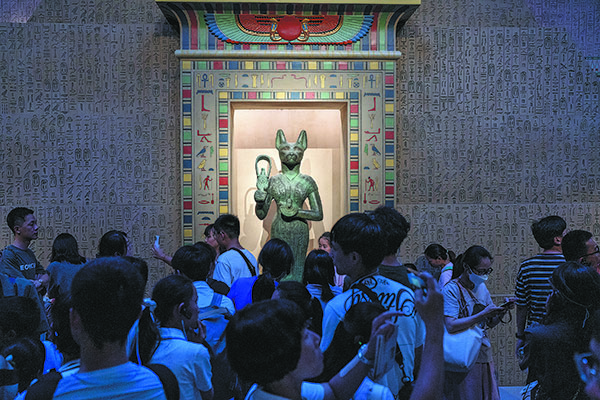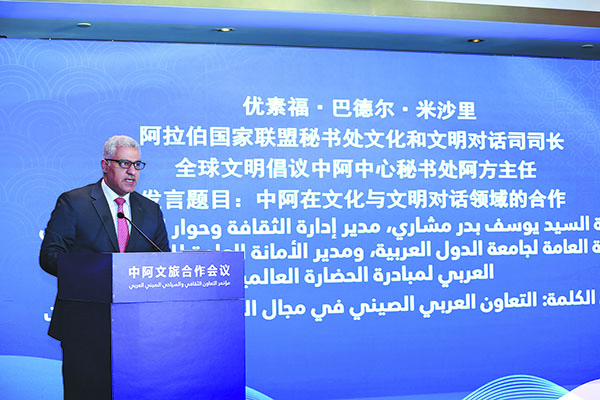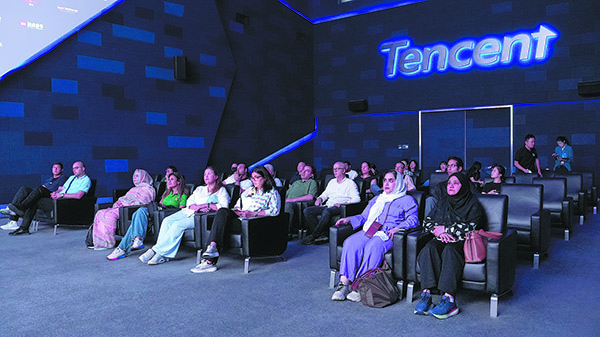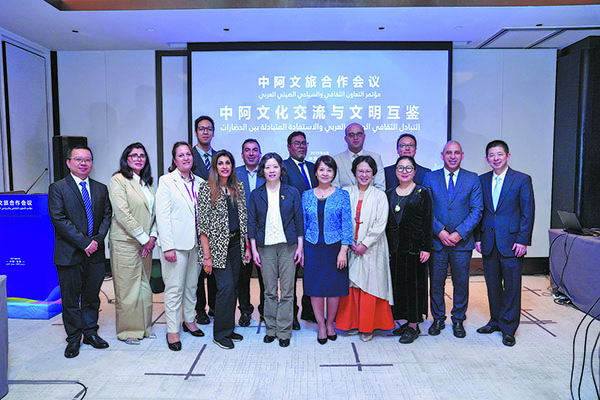
Shanghai Museum's exhibition On Top of the Pyramid: The Civilization of Ancient Egypt, which concluded in August, attracted over 2.77 million visitors for a period of 13 months, setting a new world record for attendance at a paid special exhibition in a museum. [Photo provided to China Daily]
China-Arab training program presents a new model of collaboration, blending dialogue, research partnerships and mutual tourism growth, Yang Feiyue reports.
Omar Dinia, deputy director of strategy and cooperation at Morocco's Ministry of Tourism, Handicrafts, and Social and Solidarity Economy, had a blast during his visit to Shenzhen in mid-September.
"What impressed me most was the drone that delivered the coffee we ordered in a park. I have visited all the continents of the world but have never experienced anything like this in any other country. It was truly a dream-like experience," he says.
In the city of South China's Guangdong province, Dinia also visited several renowned cultural landmarks, including the Shenzhen Museum of Contemporary Art and Urban Planning, Lianhuashan Park and Nantou ancient town, as well as the world's first 6S robot store and Tencent headquarters.
He says he was amazed to learn how much Shenzhen has changed in the past four decades, transforming from a small fishing village to an international metropolis.
Dinia is among more than 20 high-level officials, experts and scholars from the culture and tourism authorities of 11 Arab countries, including Egypt, Algeria and Morocco, as well as representatives from the Secretariat of the League of Arab States who joined the 2025 Training Program for Arab Officials and Scholars in Culture and Tourism.
The Shenzhen experience was part of the program that was hosted by the Bureau of International Exchange and Cooperation of China's Ministry of Culture and Tourism.
Concluding on Sept 24, the initiative took participants to Shenzhen and Beijing, where they explored sites of historical and cultural significance, sampled new cultural and tourism products, and attended lectures delivered by Chinese experts and academics.
According to the host, the training program was designed to enhance Arab officials' and scholars' understanding of Chinese modernization and create opportunities for China and Arab countries to explore new models of cooperation in culture and tourism.
Officials on both sides agree that the program reflects the fast-growing ties between China and Arab states.

A participant of the 2025 Training Program for Arab Officials and Scholars in Culture and Tourism poses for a photo with a robot in Shenzhen, Guangdong province, in mid-September. [Photo provided to China Daily]
The two sides have achieved substantial outcomes through a variety of joint initiatives, including co-hosting culture and tourism years, art festivals, and performances of traditional music.
At the China-Arab Culture and Tourism Cooperation Conference held in Beijing on Sept 19, which gathered all program participants, Maha Abdullah Alsenan, Saudi Arabia's deputy minister for Research and Cultural Heritage Affairs, highlighted the importance of such cultural exchanges.
The Saudi-Chinese Cultural Year 2025 aims to celebrate this friendship that carries the visions and expectations of both sides and is dedicated to realizing sustainable development that reflects shared cultural values and keeps pace with global transformations, Alsenan notes.
"We are delighted to see that, building on these partnerships, our mutual understanding continues to deepen. Through sustained efforts, we have built bridges of communication, achieving greater cultural integration and shared understanding via cultural projects, programs and initiatives — all made possible by the joint efforts of Saudi Arabia and China," she says.
She also highlights the launch of a new research fund, established in collaboration with the China-Arab Cultural and Tourism Cooperation Research Center. The fund supports projects across multiple dimensions of bilateral relations, including cultural heritage, history, language, literature, translation, performing and visual arts, digital culture, cultural economics, and the creative industries.
"We received 153 applications from scholars in Saudi Arabia, China and other countries. Today, we are pleased to announce that 20 scholars will receive grants — 10 funded by the Saudi Ministry of Culture and another 10 by the China-Arab research center," she says.
In addition, the Saudi side is also supporting four research projects in partnership with Peking University, aimed at promoting the exchange of experience and knowledge. Seminars and lectures have been held in both countries to enhance intellectual and cultural dialogue.
"We firmly believe in the importance of building strong partnerships with China," she says.

Yousef Bader Meshari, director of the culture and dialogue of civilizations department at the Secretariat of League of Arab States, delivers a keynote speech at the China-Arab Culture and Tourism Cooperation Conference in Beijing, on Sept 19. [Photo provided to China Daily]
Yousef Bader Meshari, director of the culture and dialogue of civilizations department at the Secretariat of the League of Arab States and Arab Secretariat of the China-Arab Center for the Global Civilization Initiative, describes the program as a significant step in implementing the outcomes of both the inaugural China-Arab States Summit held in 2022 and the 10th ministerial conference of the China-Arab States Cooperation Forum in 2024.
"The Arab region is home to profound historical heritage, rich religious traditions, and a time-honored cultural landscape, while China is celebrated for its profound civilization and globally renowned cultural and tourism resources," Meshari says.
"Collaboration in culture and tourism between China and Arab countries offers a strategic opportunity to deepen civilizational dialogue, expand economic and cultural partnerships, and foster exchanges — particularly in the domain of human resources," he adds.

Participants of the training program visit the Tencent headquarters in Shenzhen. [Photo provided to China Daily]
In recent years, the two sides have launched numerous joint initiatives that strengthened mutual understanding, boosted tourism flows and encouraged investment, he notes.
Huang He, deputy director of the Shanghai Museum, shares that the recently concluded On Top of the Pyramid: The Civilization of Ancient Egypt exhibition attracted over 2.77 million visitors for a period of 13 months, setting a new world record for attendance at a paid special exhibition in a museum.
Organized in collaboration with the Supreme Council of Antiquities of the Arab Republic of Egypt, this exhibition featured 788 ancient Egyptian artifacts on loan from seven major Egyptian institutions. More than 95 percent of the artifacts were exhibited in Asia for the very first time, Huang says. "Not only was this exhibition the largest and highest-caliber showcase of ancient Egyptian civilization ever held in Asia, but it also marked the first time a Chinese national museum partnered directly with the Egyptian government to present a world-class archaeological exhibition unveiling the latest discoveries from ancient Egypt," Huang says.
The event also generated a noticeable tourism boost. During the exhibition period, Egypt's Ministry of Tourism and Antiquities reported a 65 percent increase in Chinese tourists visiting the country.
In terms of revenue, the exhibition generated over 760 million yuan ($106.5 million), including more than 320 million yuan from ticket sales and over 440 million yuan from cultural creative products and derivative activities, according to museum figures.
"It has set a new benchmark for the integrated development of culture, tourism, commerce, sports and exhibitions," Huang adds.
He believes the success of the exhibition provided a replicable model for global cultural exchange and mutual learning.
"The Shanghai Museum will continue to deepen communication and exchanges with museums around the world, particularly by strengthening practical cooperation with Arab countries in the field of cultural heritage," Huang says.

Participants take pictures after discussing China-Arab cultural exchange during the Beijing conference. [Photo provided to China Daily]
As 2025 marks the China-Saudi Arabia Year of Culture, the museum is already deeply involved in curatorial discussions with the Saudi side, contributing expertise in areas such as ancient Chinese calligraphy, painting, ceramics and seal impressions, he says.
Ji Jinbiao, president of Beijing International Studies University, points out that the exchange and cooperation between China and Arab nations are deeply rooted in history, dating back more than 2,000 years to the Han Dynasty (206 BC-AD 220) when royal emissary Zhang Qian's missions to the West opened the ancient Silk Road.
"In the 14th century, the Moroccan traveler Ibn Battuta visited China, and his writings in The Rihla have been widely celebrated for centuries. Entering the 21st century, cultural and tourism cooperation between China and Arab countries has continued to deepen and has now reached an unprecedented level," Ji says.
He emphasizes that today's cooperation has evolved into a systematic endeavor that promotes civilizational dialogue, supports national strategies, drives economic development and strengthens grassroots friendship.
"At the same time, China-Arab cultural and tourism cooperation has transcended bilateral dimensions, becoming an important pathway for implementing the Global Civilization Initiative (proposed by China in 2023) and advancing the building of a China-Arab community with a shared future," Ji says.
Yang Xiaoyu contributed to this story.
 Editor:Cai Xiaohui
Editor:Cai Xiaohui